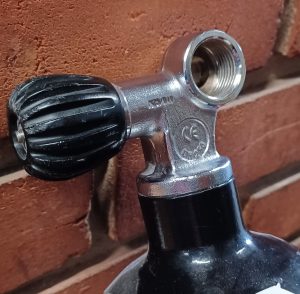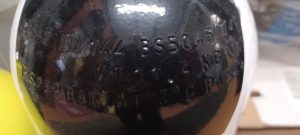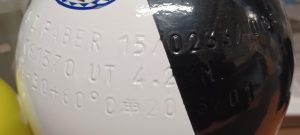Air gun tanks (cylinders) are normally the same basic tank used in scuba diving but may be fitted with a specialist valve rather than a standard scuba valve. If you need a tank we can obtain them to order, fitted with the valve of your choice. The standard tank sizes are: 3 litre, 5 litre, 1o litre, 12 litre or 15 litre.
 Fills and servicing
Fills and servicing
Here at Dive Odyssea, we can fill your air gun tanks with <>232 bar, providing the tank is “in test”. If it isn’t “in test” we can test them for you. Most air gunners have a tank (cylinder) to provide compressed air for their weapon but not many are aware of the regulations concerning air gun tanks.
The regulations† governing the servicing of any compressed air tank are set in stone by the Health and Safety Executive. It is easy to understand why when you consider 232 bar (ie around a hundred times the pressure of your car tyres) is the standard working pressure of most tanks. A tank is made of either steel or thick aluminium and would shatter under excess pressure if the tank is not structurally sound so you can understand why an “out of test” tank cannot be accepted for filling.
So, let’s try to clarify the test regime required for your tank:
| A tank that can be used for Scuba Diving must be tested every two and a half years. If your tank valve looks like this, it’s a “scuba tank”, even if you only use it for filling your air gun. | If the tank is fitted with a valve that cannot be used for Scuba, it needs only a five year test cycle. This is a typical “air gun” valve and fitting: |
 |
 |
If a tank fails testing, legally it cannot be returned to you an must be sent for destruction.
Markings
We must be able to read the original manufacturer’s markings on the tank:
 |
 |
They vary from one tank manufacturer to another but they give specifications and pressures to be tested against: they also give the date of manufacture and a unique serial number.
Other markings may be proof markings showing where and when tests were carried out.
It is important you do not obliterate any of these markings because a flash paint job is nice but it could prevent the testing of the tank in the future if we can’t read the data.
If in doubt call in and see us and we can advise, for free! Tests are in the region of £50 depending on any parts needing replacement.
† In more detail:
| 30 Month Test | 5 Year Test |
| The valve is removed and the threads on the valve stem and tank neck tested for wear or misalignment. The tank walls internal and external are checked for corrosion and echo tested to check the current wall thickness. The valve is serviced torqued back in place and the tank filled. | As well as the 30 month check list, the tank is subjected to a “hydro test”. This is the approved way to test the structural integrity of any compressed gas tank. It is performed by filling the tank with water, and then pressuring the tank to it’s recommended test pressure. The expansion of the tank is measured, recorded and analyzed. |
| HSE Legislaton | |
| BS EN ISO 18119:2018/Amd 1:2021 |
Steel and Aluminium |


 Fills and servicing
Fills and servicing